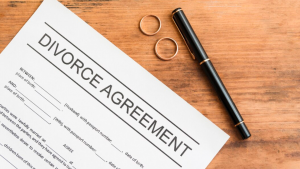What Is A Divorce Property Settlement Agreement?
A divorce can be a difficult and emotionally charged process, but when it comes to the division of property, things can get even more complex. In Australia, a key aspect of divorce is the Property Settlement Agreement. This legal document outlines how assets and liabilities are to be divided between the parties involved. But what exactly is a Divorce Property Settlement Agreement, and how can you navigate the process? Let’s dive into this important aspect of Australian divorce law.
Understanding the Basics
A Divorce Property Settlement Agreement, often simply referred to as a ‘Settlement Agreement,’ is a legally binding document that outlines the division of property and financial assets between two parties going through a divorce. This document aims to provide a fair and equitable resolution, ensuring both parties receive their fair share.
The key elements of a Settlement Agreement include:
1. Assets and Liabilities: Clearly list all assets and debts that need to be divided. This can encompass real estate, vehicles, bank accounts, investments, and more.
2. Valuation: Determining the value of each asset and liability to ensure a fair division.
3. Distribution Terms: Deciding how these assets and liabilities will be divided between the parties. This could involve a percentage-based split, a sale of assets, or other agreed-upon methods.
4. Legal Documentation: The final and critical step is to put all the agreed terms in writing, making it legally binding.
ALWAYS KNOW YOUR RIGHTS AND KNOW WHERE YOU STAND
By consulting one of our accredited family law mackay specialists.Steps to Writing a Divorce Property Settlement Agreement
Now that you understand what a Divorce Property Settlement Agreement is, let’s delve into the steps involved in creating one.
Start With Basic Information About The Marriage
Before you can begin drafting the Agreement, you’ll need to gather some key information about the marriage. This includes the date of the marriage, any prenuptial agreements, and details about any children involved. You’ll also need to establish the separation date, which is a crucial milestone in the divorce process.
It’s essential to provide an accurate account of the marital history as this forms the foundation of the Agreement.
Identify the Properties
Once you have the basic information in place, it’s time to identify all the properties involved in the marriage. This can include real estate, personal assets, investments, and even shared debts. The more comprehensive your list, the smoother the division process will be. Remember, transparency is key to a successful Property Settlement Agreement.
Estimate Their Value
Valuing the assets and liabilities is a crucial step in the process. Determining the value of each item will help ensure an equitable division. You may need to consult with experts or professionals, such as appraisers or accountants, to get accurate valuations, especially for complex assets like real estate or investments.
Work Out The Terms Of Distribution
With a clear understanding of the asset’s value, the next step is to work out how they will be distributed. This can be a challenging phase, as it involves negotiation between the parties. You’ll need to agree on the terms of distribution, whether it’s a percentage-based split or other arrangements.
Remember, the goal is to achieve a fair and equitable settlement that both parties can accept.
ALWAYS KNOW YOUR RIGHTS AND KNOW WHERE YOU STAND
By consulting one of our accredited family law mackay specialists.Put the Agreed Terms in Writing
Once you’ve come to an agreement on property division, it’s time to formalize it in writing. This is where the Property Settlement Agreement comes into play. The Agreement should include a detailed list of assets and liabilities, their respective values, and the terms of distribution. It’s essential to be as precise as possible to avoid any ambiguity that could lead to disputes later on.
What If a Divorce Property Settlement Agreement Cannot Be Reached?
While it’s ideal for both parties to reach an amicable agreement, sometimes this is not possible. In such cases, you might be wondering what your options are.
If you find it impossible to agree on the terms of property division, you can turn to the legal system. You can file an application with the Family Court of Australia, which will then make a decision on your behalf. Keep in mind that this route can be time-consuming, and emotionally taxing, and may not result in the outcome you desire.
Another option is to seek mediation. Mediation involves a neutral third party helping you and your ex-spouse come to a mutual agreement. It’s often a more cost-effective and less confrontational approach compared to litigation.
Getting an Attorney to Review your Divorce Settlement Agreement
Whether you’ve successfully negotiated a Property Settlement Agreement or you’re considering other options, it’s advisable to have an attorney review the document.
A legal expert can ensure that the Agreement adheres to Australian law and is equitable to both parties. They can also offer guidance and advice, helping you avoid common pitfalls in the process.
Moreover, having an attorney involved can significantly enhance the validity and enforceability of the Agreement. It’s a crucial step in ensuring the highest degree of protection for both parties.
Conclusion
In the challenging process of divorce, a Divorce Property Settlement Agreement is a critical document that can simplify the division of property and assets. By following the steps outlined in this blog post, you can create an Agreement that is fair, comprehensive, and legally binding.
Remember, transparency, accurate valuation, and open communication are the keys to a successful Property Settlement Agreement. However, in cases where agreement cannot be reached, legal options such as mediation or court intervention are available to help resolve the matter.
Navigating a divorce is never easy, but with the right approach and professional guidance, you can ensure that your Property Settlement Agreement upholds the principles of E-E-A-T – Expertise, Experience, Authority, and Transparency – while providing a fair and equitable solution for all parties involved.
ALWAYS KNOW YOUR RIGHTS AND KNOW WHERE YOU STAND
By consulting one of our accredited family law mackay specialists.Frequently Asked Questions (FAQ)
Q1: Can a Divorce Property Settlement Agreement be modified after it’s been finalized?
A1: Yes, in some cases, a Divorce Property Settlement Agreement can be modified. If both parties agree to the changes, an addendum can be created. However, any modifications should be made with legal counsel to ensure they are in compliance with Australian law.
Q2: What happens if one party doesn’t comply with the terms of the Property Settlement Agreement?
A2: If one party fails to adhere to the terms of the Agreement, legal action can be taken. This can include seeking enforcement through the Family Court of Australia. Having a legally binding Agreement in place can help ensure that both parties meet their obligations.
Q3: Is it possible to create a Property Settlement Agreement without the involvement of attorneys?
A3: While it’s possible to create a Property Settlement Agreement without legal representation, it’s highly advisable to consult with an attorney. Attorneys can provide valuable guidance, ensure that the Agreement is legally sound, and help protect your rights and interests throughout the process.














